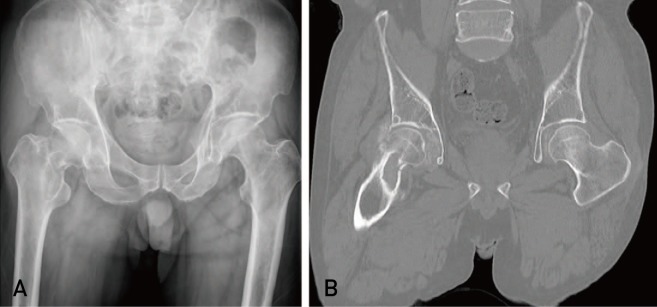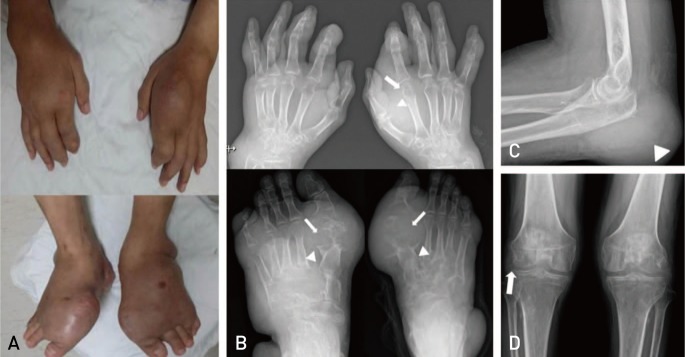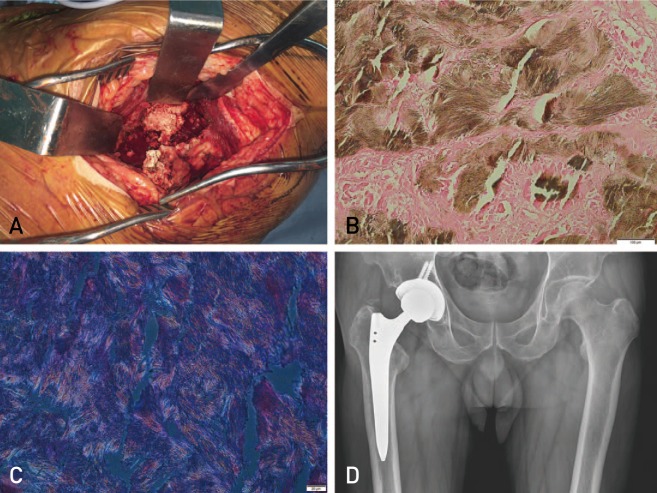Hip Pelvis.
2019 Dec;31(4):238-241. 10.5371/hp.2019.31.4.238.
Pathological Fracture of the Femoral Neck due to Tophaceous Gout: An Unusual Case of Gout
- Affiliations
-
- 1Department of Orthopaedic Surgery, Barun Mind Hospital, Daejeon, Korea.
- 2Department of Orthopaedic Surgery, Chungnam National University School of Medicine, Daejeon, Korea. dshwang@cnu.ac.kr
- KMID: 2464241
- DOI: http://doi.org/10.5371/hp.2019.31.4.238
Abstract
- A 48-year-old man visited the emergency room with right hip pain that started abruptly while walking out of the bathroom. Computed tomography showed an intraosseous mass in the femoral neck. The patient had a 15-year history of gout and had numerous bilateral tophi in his hands, feet, knees, and elbows. After operation, we diagnosed a pathological fracture due to intraosseous tophi. Patients with hip pain who have many subcutaneous tophi and long-standing gout should be diagnosed carefully. Peri-hip joint pain caused by gout is uncommon, however, if a patient complains of pain, a simple X-ray may be required. If intraosseous tophi are present, appropriate treatment (e.g., strict hyperuricemia control with or without prophylactic internal fixation), may be required before fracture occurs.
MeSH Terms
Figure
Reference
-
1. Lawrence RC, Helmick CG, Arnett FC, et al. Estimates of the prevalence of arthritis and selected musculoskeletal disorders in the United States. Arthritis Rheum. 1998; 41:778–799. PMID: 9588729.
Article2. Agudelo CA, Wise CM. Gout: diagnosis, pathogenesis, and clinical manifestations. Curr Opin Rheumatol. 2001; 13:234–239. PMID: 11333355.
Article3. Nguyen C, Ea HK, Palazzo E, Lioté F. Tophaceous gout: an unusual cause of multiple fractures. Scand J Rheumatol. 2010; 39:93–96. PMID: 20132078.
Article4. Bates TA, Renner JB, Jonas BL. Pathologic fracture of the hip due to severe gouty arthritis. J Rheumatol. 2006; 33:1889–1890. PMID: 16960948.5. Burnham J, Fraker K, Steinbach H. Pathologic fractures in an unusual case of gout. AJR Am J Roentgenol. 1977; 129:1116–1119. PMID: 413374.
Article6. Loeb JN. The influence of temperature on the solubility of monosodium urate. Arthritis Rheum. 1972; 15:189–192. PMID: 5027604.
Article7. Mantle B, Gross P, Lopez-Ben R, Alarcón GS. Hip pain as the presenting manifestation of acute gouty sacroiliitis. J Clin Rheumatol. 2001; 7:112–114. PMID: 17039107.
Article8. Dalbeth N, Clark B, Gregory K, et al. Mechanisms of bone erosion in gout: a quantitative analysis using plain radiography and computed tomography. Ann Rheum Dis. 2009; 68:1290–1295. PMID: 18708415.
Article
- Full Text Links
- Actions
-
Cited
- CITED
-
- Close
- Share
- Similar articles
-
- Tophaceous Gout in the Rotator Cuff with Impingement Syndrome: A Case Report
- Tophaceous Gout Involving the Bipartitle Patella: A Case Report
- Symptomatic Tophaceous Gout in the Bilateral Patellae
- Intratendinous Tophaceous Gout Mimicking Cellulitis after Achilles Tendon Repair
- Two Cases of Chronic Tophaceous Gout in Systemic Lupus Erythematosus




